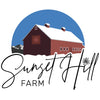History of Lowlines (American Aberdeen)
History of Lowlines

History of Lowlines
Lowline cattle, as we know them today, resulted from a breeding program conducted in Australia on traditional framed Angus Cattle. The goal of the project was to produce more beef per acre. It was found that breeding for low yearling growth rates and ultimately decreasing the topline of the animal, hence the name “Lowline”, achieved this task. The topline referred to is the back of the cow. Well bred beef cows will have a linear line to their back when viewed from the side, which is especially apparent when showing cattle at agricultural fairs. At the culmination of the study, the cows were dispersed by sale and the Australian Lowline Cattle Association was formed.
The first Lowline Cattle were introduced in the United States in 1997, and the American Lowline Registry was created soon after. The docile temperament of the Lowline cattle, as well as ease of calving and efficient size, made them an excellent candidate for all different regions throughout the United States.
Benefits
- Lowlines are efficient cattle, this means they have lower food requirements than larger sized animals These animals are great for operations of all sizes, as well as grass-fed operations. You are able to stock at a higher density per acre.
- Ease of calving, small birthweight of calves (or fullbloods average 42 lbs. at birth).
- Docile and very easy to handle. They are gentle on equipment and fencing and great for youth to handle. These animals make great 4-H projects.
